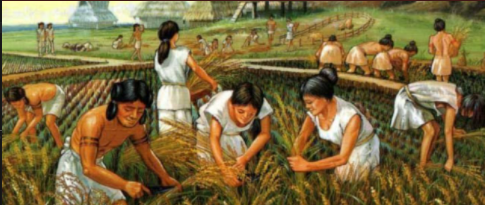Bharat: Advancement of earth’s earliest civilization.
- Sonal

- Nov 3, 2020
- 4 min read

Ancient Agricultural System
A poet describes India in a Sanskrit poem as "idaṃ bhārataṃ devalokena tulyam" Beloved India, always to be worshipped. The nation that carried an advanced civilization whose descendants were so great that they believed in always giving and not claiming their credits. That is why British and foreign people took the things, ideas, and made patents and claimed the credits. A happy civilization is that where there is no scarcity and Indian civilization was based on agriculture where the farmers were experts in the techniques that could actually grow crops and foods that were good for health. Not like today where everything contains impurities and chemicals that eating such foodstuffs our health deteriorates.
India was one of the oldest regions for cultivated plants, which included rice, jute, cotton, pulses, black pepper, wheat, rye, linseed, walnuts, and fruits such as apple, pear, and mango. The earliest forms of vegetive propagation were bananas, sugarcane, yam, palm, etc. Animals were also domesticated for agricultural purposes, such as cows, buffaloes, goats, sheep, fowl, and possibly elephants back then as well Animals were also domesticated for agricultural purposes, such as cows, buffaloes, goats, sheep, fowl, and possibly elephants back then as well. It has been found that riverboats were used in ancient times for agricultural trade and devices such as seed grills, carts, and granaries were found in Harappan sites, and other places yielded implements for ginning, spinning, and weaving cotton. In the Rig and Atharva, Vedas agriculture was considered a noble occupation.
In fact, the Atharva Veda regarded it almost as important as human procreation. Dried cow dung was prescribed and used as manure, which has also been found that when combined with cow urine and made 125 into a dried paste, is one of the best fertilizers today for putting nutrients back into the soil, even more effectively and naturally than chemical Fertilizers. From the Vedic literature, it seems that Vedicage farmers also knew how to maintain soil fertility by crop rotation and changing crops from season to season. People investigated, tested, and examined nature and the world of plants and vegetables to a fine degree. In fact, the Atharva Veda divided plants into seven sub-parts, such as trees, grass, herbs for medicine, shrubs, creepers, etc. Then we find in such texts as the Mahabharata, Vishnu Purana, Matsya Purana, etc., along with books by Parashar, Charaka, Sushruta, Udayan, and so on, greater descriptions and analysis of the various plants. They even recognized the presence of the life-force within them.
For example, the sage Charaka explains that trees also have a life similar to other living beings, and also have feelings. In the ancient Krishi-Parashara from about 400 BCE, we find the details for designing the plough with the names for its different parts in Sanskrit, with little differences in the basic plough that we see today. This text has been translated by the Asian Agri-History Foundation in Secunderabad, India. It gives lists of tools to be used, methods of good farming management for the high yield of crops, implements to be used, operations, harvesting, dealing with rainfall, management of cattle, along with advice on seed collection and storage, etc.
The Krishi-Parashara and the Brihat Samhita also were known to give simple astrological models for predicting rain by using basic astrology with climate conditions, depending on the season. For example, Parashar’s method utilized the positions of the Moon and Sun, while the Brihat Samhita, by Varahamihira (505-587 CE) considered lunar mansions, and today also such methods are still used today by many farmers in India. The Krishi-Parashara also provided descriptions of what the cow shed should be, and discussed the importance of cleanliness to keep the cows protected from diseases. The Rig Veda also includes references on how best to maintain cows and manage them properly with the right foods or fodder to eat and water to drink and cow killing for food was never encouraged in the Vedic period. In a closer analysis of the Vrikshayurveda Parashar, we find a detailed description of the process of the growth of a tree from the seed and he explains that at first the water is absorbed in the jelly-like structure and a nucleus are formed and then slowly it takes up the energy and nutrition from the earth. Then the structure develops into an incipient seed and later takes the form of a solid tree.
This is the process of formation and protoplasm which has been described in the chapter Beejatva Adhikaran. The second chapter deals with the soil and the kinds and qualities of the soil and the third chapter describes fourteen different kinds of forests. The fourth chapter, Vrikshang Sutradhyay, deals with the physiology of plants and trees, including photosynthesis. Pushpaang Sutradhyay in the fifth chapter outlines flowers, including the many kinds of flowers, the parts of them, and what are these parts. The sixth chapter, Falaang Sutradhyay, deals with the many kinds of fruits, their qualities, diseases, and classifications. The seventh chapter deals with parts of the tree, and the eighth chapter describes the process of the growth of the tree.
Thus, Parashar went very deeply into the whole process of growth, development, and care for the plants. Sage Parashar also describes various aspects of the microscopic nature of the cell and says that it has protoplasm and cell membranes, and is created in the phase of the seed in which it absorbs terrestrial juices and energy. Thus, we find here that he is practically describing the parts that could hardly be seen without a microscope.




















































Comments